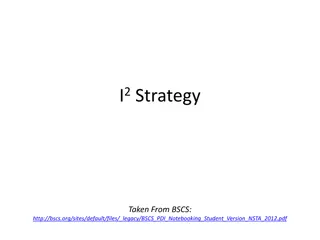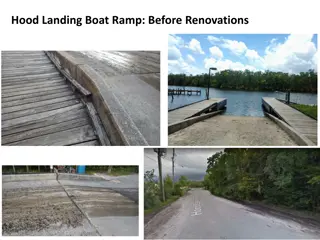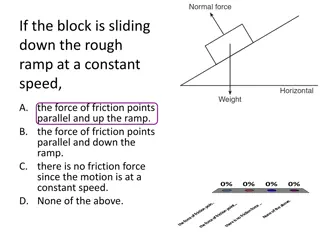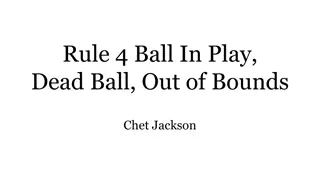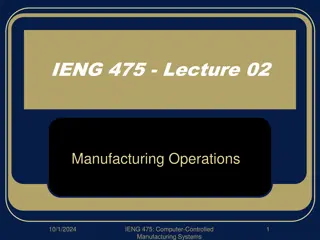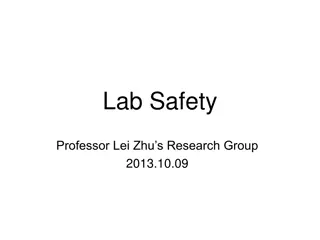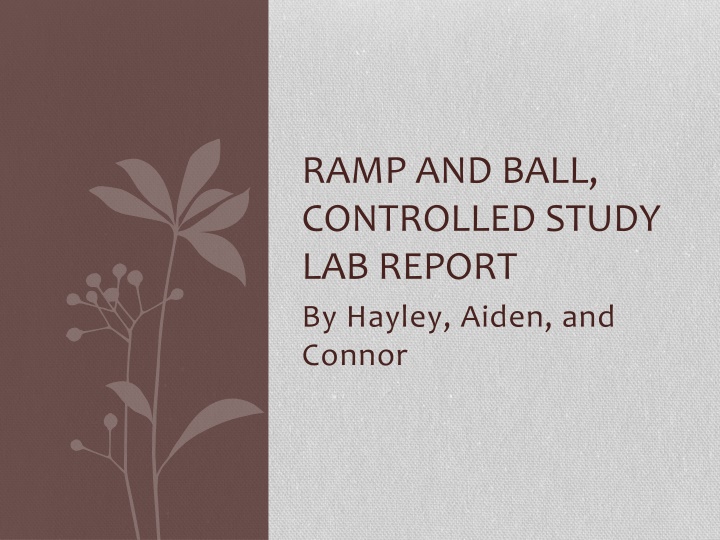
Investigation on Golf Ball Bounce in Relation to Release Distance
This controlled study lab report by Hayley, Aiden, and Connor explores how the release distance of a golf ball affects its bounce from bounce 1 to bounce 2. The experiment involved manipulating the release point and measuring the distance the ball traveled. Various observations and data were recorded to analyze the impact of the release distance on the bounce. The report outlines the problem statement, hypothesis, controlled variables, manipulated variables, procedures, observations, and a data table from the experiment.
Download Presentation

Please find below an Image/Link to download the presentation.
The content on the website is provided AS IS for your information and personal use only. It may not be sold, licensed, or shared on other websites without obtaining consent from the author. If you encounter any issues during the download, it is possible that the publisher has removed the file from their server.
You are allowed to download the files provided on this website for personal or commercial use, subject to the condition that they are used lawfully. All files are the property of their respective owners.
The content on the website is provided AS IS for your information and personal use only. It may not be sold, licensed, or shared on other websites without obtaining consent from the author.
E N D
Presentation Transcript
RAMP AND BALL, CONTROLLED STUDY LAB REPORT By Hayley, Aiden, and Connor
How does the release distance affect the bounce of a golf ball from bounce 1 to bounce 2? Problem: Our problem statement was
I predict that the release distance of the golf ball will make the ball bounce further from bounce 1 to bounce 2. Hypothesis: Our hypothesis was .
Controlled Variables: -Golf ball -PVC piping -Angle of Ramp Our controlled variable was
Manipulated Variable: -Release point -Distance ball bounces Our manipulated variables was:
Dependent Variable: The distance in centimeters from bounce 1 to bounce 2. Our dependent variable was .
-Carbon Paper -Goggles -Golf Balls -Graph Paper -Lab Report -Masking Tape -Meter Tape -Scott Towels -16D Nails -2 PVC Piping Materials: Our materials were .
1. Draw a diagram. 2. Write procedure. 3. Gather materials. 4. Construct model ramp on chair. 5. Measure distance of PVC piping from floor. 6. Place nail at first point. 7. Drop ball then release nail. 8. Measure distance from bounce 1 to bounce 2. 9. Record observation and data. Procedures: For this experiment, we followed these steps
Drop 1: Dropped 44cm away from each other, didn t bounce to far apart. Drop 2: The second drop was farther apart, probably because of the height. Drop 3: The ball is starting to go faster. Drop 4: Again, it bounced father away, we needed to add another piece of paper towel. Drop 5: It bounced very far away from each other. Drop:6 The last drop was definitely affected by the height of the release distance. Observations: Our observations during this experiment was ..
Data Table: group 10cm 20cm 40cm 60cm 80cm 85cm 1 44cm 60cm 69cm 100cm 115cm 120cm 2 40cm 62cm 84cm 99cm 120cm 124.5 3 43cm 57cm 70cm 90cm 115cm 127cm 4 38cm 51cm 73cm 88cm 103cm 112cm 5 43cm 51cm 75cm 99cm 114cm 112cm 6 26cm 49cm 63cm 81cm 99cm 111cm 434cm total 234cm 329cm 551cm 666cm 706.5 average 39cm 55cm 72cm 92cm 111cm 117.5
Class Results for Distance Release Line Plot 140 120 Our class results were.. Bounce Distance (cm) 100 group 1 80 group 2 60 group 3 group 4 40 group 5 group 6 20 0 10 cm 20 cm 40 cm 60 cm 80 cm 85 cm Release Distance (cm)
Possible Explanations: One possible explanation is the release distance that the ball took of at. Another possible explanation is the angle that the PVC pipe was balanced on. Some possible explanations are .
The height of the release distance from bounce 1 to bounce 2 is effected by the release distance. If you release the ball from a tall height, the faster it will go down the ramp. Having a higher release distance gives the ball more time to pick up speed. Conclusion: My conclusions were .




